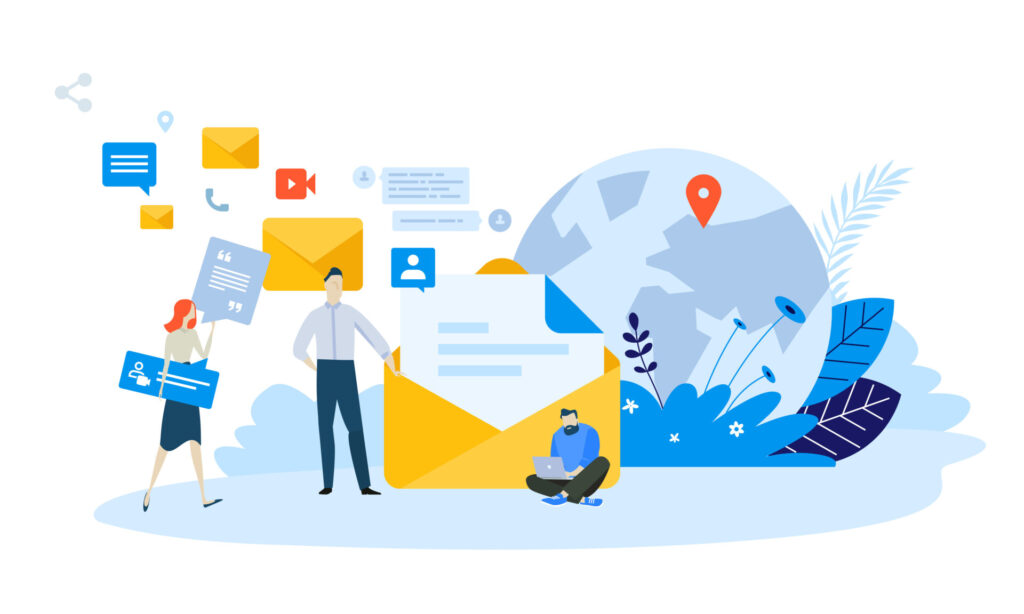
Personalization is the foundation of account-based marketing (ABM), and it will be the foundation of your strategy’s success.
In ABM, your goal isn’t to speak to everyone. It’s to speak directly to the right people: decision-makers at the companies that matter most to your business. The best way to do that is with content that feels intentionally crafted for them.
Let’s explore why personalization is so important in ABM, what types of personalized content work best, and how to create messaging that truly resonates with your most valuable accounts.
Why Personalization Is the Heart of Account-Based Marketing
Traditional marketing casts a wide net as you create one message for a broad audience in hopes that it will attract the leads that fit your ideal customer profile (ICP).
Account-based marketing flips that model on its head. Instead of marketing to many, you’re marketing to specific companies and key individuals within those companies.
To make that work, your content must:
- Reflect each account’s industry, goals, and challenges.
- Address decision-makers’ specific pain points.
- Demonstrate how your solution directly impacts their success.
Generic messaging can’t really do that. Personalized content, however, shows that you’ve done your homework and that you understand who they are, what they value, and how your business can help them move forward.
The Results Speak for Themselves
Recent studies have shown that personalized marketing campaigns:
- Increase engagement by up to 6x compared to generic campaigns.
- Generate higher ROI and shorter sales cycles in ABM programs.
- Strengthen brand perception (80% of buyers are more likely to purchase from a company that personalizes their experience).
What does all that mean? It proves that personalization transforms your brand from one of many to the one that “gets them.”
Levels of Personalization in ABM
Not all ABM campaigns require the same depth of personalization. The level you choose depends on your resources, account value, and campaign goals.
Here’s a simple framework for thinking about levels of ABM personalization:
1. One-to-One (Strategic ABM)
Strategic ABM requires highly personalized campaigns focused on individual accounts. Every piece of content in the campaign, from emails to landing pages, is created specifically for that specific company. This level is best for your top-tier, high-value accounts with significant revenue potential.
Example:
Let’s say you’re a commercial construction company that wants to win a contract with a large healthcare network. Through your partnership with M&R, we can develop a strategy that includes a microsite just for that network, showcasing your experience in healthcare construction, safety compliance, and previous hospital projects. Your site may also include data tailored to that organization’s region and needs.
2. One-to-Few (ABM Lite)
ABM Lite focuses on small groups of accounts with shared characteristics, like similar industries or challenges. These campaigns are semi-personalized, using the same core content that can be slightly adapted per segment. ABM Lite is great for scaling personalization without overwhelming your resources.
Example:
Let’s say you’re an SaaS provider wanting to target mid-sized financial firms. You can distribute the same digital resources (like a blog series or an eBook) to your targets but also distribute personalized microsites and case studies that are similar but adjustable to each firm.
3. One-to-Many (Programmatic ABM)
Programmatic ABM uses automation and data to deliver industry-level personalization at scale. The messaging still feels relevant, but it’s not hyper-specific to each company. This level is ideal for building awareness among a broader set of qualified accounts.
Example:
Let’s say you’re a manufacturing supplier. You can run LinkedIn ads that dynamically insert industry names into headlines and calls to action. For instance, you can run a set of ads “for automotive distributors” and another set “for packaging companies,” or any other type of company you want to target.
Step-by-Step: How to Create Personalized Content for ABM
Once you’ve identified your target accounts and decided on your level of personalization, the next phase is to create the content that will make your ABM strategy thrive.
Here’s how:
Step 1: Research Each Account Thoroughly
Before you create anything, you need to deeply understand who you’re talking to. That means going beyond surface-level demographics.
Dig into:
- Company background: What is their size, location, structure, and market position?
- Recent news or press: Have they experienced recent mergers, expansions, new product launches, or challenges?
- Key decision-makers: What are the titles, responsibilities, and professional interests of the people who can decide to partner with you?
- Pain points: What’s slowing their growth or causing friction?
- Goals and KPIs: What do they care about most? Efficiency, profitability, innovation, market share, or something else?
The goal is to identify insights that help your message feel relevant and timely. When a decision-maker reads your email or case study and thinks, “That’s exactly what we’re dealing with,” you’ve nailed personalization.
Step 2: Develop Core Messaging That Speaks to Their Needs
Your content should always start with the customer’s perspective, not your product’s features.
Focus on the problem they’re trying to solve, then connect the dots to how partnering with you helps.
Ask yourself:
- What’s their biggest challenge right now?
- How does that challenge affect their business outcomes?
- What transformation could they achieve with your help?
For example, instead of saying:
“Our data platform integrates with multiple systems and improves reporting accuracy.”
You can say:
“Your team shouldn’t waste hours reconciling reports across disconnected systems. Our platform unites your data, saving time and reducing costly errors.”
This shift from sharing what you offer to why your offerings should matter to them is the essence of personalized messaging.
Step 3: Create a Content Map for Each Stage of the ABM Funnel
Different decision-makers within your target accounts engage with content at different stages of the buying journey. Personalized content should seamlessly guide them from awareness to decision.
| Funnel Stage | Goal | Personalized Content Examples |
| Brand Awareness | To introduce your brand and expertise. |
|
| Considering a Partnership | To build trust and prove understanding. |
|
| Deciding on a Partnership | To drive conversion with evidence. |
|
This mapping ensures that every piece of content serves a strategic purpose and is not just filling space. The goal should always be to move prospects closer to a partnership.
Step 4: Choose the Right Channels for Delivery

Even the most relevant content won’t make an impact if it’s not seen. Choose the right mix of channels to reach each account where they already spend time.
Common ABM delivery channels include:
- Email marketing that provides for personalized subject lines and messaging.
- LinkedIn Ads that tailor visuals and copy to reflect the industry or company.
- Retargeting ads that keep your brand in front of engaged prospects.
- Custom microsites or landing pages that create an exclusive hub with relevant resources for key accounts.
- Direct mailers that deliver personalized messages from your sales team.
- Events and webinars designed for a small group of decision-makers.
Each channel offers a unique way to demonstrate personal attention and value.
Step 5: Test, Measure, and Optimize
Personalization doesn’t stop once your campaigns are live.
Use data to learn what’s working and what’s not so you can fine-tune your approach.
Track metrics such as:
- Engagement rates (clicks, opens, downloads)
- Account-level website activity
- Content influence on pipeline growth
- Conversion rates for personalized campaigns
Use these insights to evolve your personalization tactics over time. You might find, for instance, that certain industries respond better to video content, while others prefer data-driven reports or webinars.
Examples of Personalized ABM Content in Action
To make this more tangible, here are a few real-world examples of what personalization can look like in an ABM campaign:
Custom Industry Reports
M&R helps your manufacturing client create industry-specific reports for distributors and resellers. Each version highlights trends and solutions relevant to that audience’s operations, resulting in a 40% higher engagement rate compared to generic PDFs.
Personalized Video Outreach
M&R helps a tech company create short, personalized intro videos from its account managers, which are sent directly to decision-makers. These videos reference each recipient’s company by name and their challenge areas. This level of human touch can increase response rates significantly.
Interactive Microsites or Single-Page Sites
Instead of generic landing pages, M&R designs personalized microsites for a fuel and oil company’s high-value accounts. It features the company’s logo, a tailored headline, and curated content that reflects its industry’s challenges. Microsites like this often serve as the centerpiece of one-to-one ABM campaigns.
Targeted Webinar Series
M&R creates a healthcare marketing campaign for a software company, targeting hospital administrators with webinars focused on patient engagement technology. Each webinar features use cases that mirror the hospital’s size, region, and operational structure, creating instant relevance and credibility.
Common Personalization Mistakes to Avoid
Even with the best intentions, personalization can miss the mark. Avoid these common pitfalls:
- Applying too much automation, not enough authenticity: Personalization should always feel thoughtful, not robotic.
- Overlooking the decision-making unit: Don’t just target one contact. Craft messages for influencers, users, and executives alike.
- Developing inconsistent messaging: If your ads say one thing but your emails say another, you’ll lose credibility and audiences’ trust.
- Ignoring data signals: If engagement drops, you need to know so that you can revisit your campaign and pivot as needed.
Remember that the goal of ABM personalization isn’t to show off how much you know but to show how much you understand and can help.
Bring Personalization to Life With M&R Marketing
Creating personalized content for ABM takes insight, creativity, and a deep understanding of your audience. At M&R Marketing, our full-service, in-house team of marketing pros blends strategic research with creative execution, helping you craft campaigns that resonate, convert, and strengthen long-term relationships.
Whether you need tailored content for high-value accounts or scalable ABM campaigns that reach multiple segments, M&R can help you:
- Identify target accounts and their needs
- Develop personalized messaging that drives engagement
- Design creative assets that connect emotionally and strategically
- Measure performance and continuously improve your approach
Drive Connection and Conversion With Personalized ABM Content
The best ABM campaigns shouldn’t feel like marketing; they should feel like conversations. When you personalize content around your audience’s needs, you create trust, spark engagement, and accelerate growth.
ABM at Work for Georgia Mining Association
Georgia Mining Association (GMA) is the trade organization for the state’s mine operators, mineral processors, and other related businesses. It approached M&R for a rebrand and strategic marketing that would increase membership from Georgia mining companies and the companies that serve the industry.
As part of our strategy, we redesigned the website, launched a LinkedIn campaign, began business listings, and initiated an email marketing campaign to improve engagement with targeted businesses in Georgia.
Overall Campaign Results
| 190% increase in impressions in the past 6 months | 66% increase in engagement in the past 6 months | 61% increase in conversions in the past 6 months |
Ready to Bring Personalization to Your ABM Strategy? Call M&R Today: 478-621-4491
The team at M&R Marketing is ready to help you design and deliver campaigns that make every prospective client feel like your most important client.
Call 478-621-4491or contact one of our business development managers to get started!
More ABM Articles
- What Is Account-Based Marketing (ABM)? A Strategic Shift for Modern B2B Growth
- How to Build an ABM Strategy That Actually Works
- Tools, Platforms, and Data: The ABM Tech Stack You Need
- Measuring Success: How to Track and Optimize Your ABM Campaigns
Detailed Marketing Deets
Want some profound insight into all things marketing? Check out our Definitive Guide Series for detailed information, tips, and advice regarding:
- Branding
- Business Listings Management
- Commercial Photography
- Email Marketing
- Ecommerce
- Geofencing & Location-Based Marketing
- Local SEO
- Marketing Plan
- Search Engine Marketing
- Social Media Management
- Traditional Advertising
- Video Marketing
- Website Design

